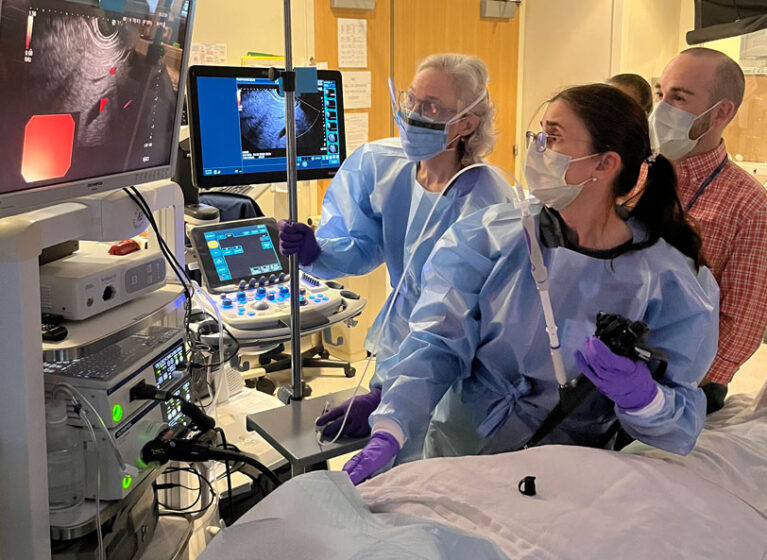
The rapidly evolving field of endohepatology is revolutionizing the way physicians diagnose and treat liver disease. A groundbreaking device, piloted at UVA Health and other centers, is part of that effort.
UVA Health’s Vanessa Shami, MD, section chief of interventional endoscopy, and Zachary Henry, MD, transplant hepatologist, have been early leaders in the field of endoscopic ultrasound (EUS) guided portal pressure measurement. This acts as a novel, safe, and effective way to help patients with cirrhosis and portal hypertension by measuring portal pressure directly. That means more consistent results for treating physicians.
“The real benefit of this technique is being able to answer multiple questions in 1 procedure,” says Henry. “That’s because this combines 3 separate procedures: upper endoscopy, a liver biopsy, and hepatic portal pressure measurement. But we’re doing it all with endoscopic ultrasound. Moreover, the results are typically better than what we get using interventional radiology biopsy. We can now fill a gap in care that’s existed for a long time.”
Combining these procedures into one provides a better patient experience. Looking ahead, the UVA Health team is working to move beyond the diagnosis during EUS.
More Information, Fewer Procedures
EUS offers one more tool for physicians to diagnose liver disease.
“There are times when patients may not be showing signs of liver disease. Patients may feel fine and have normal bloodwork,” says Shami. “If you suspect disease, you want to prove it to begin prompt treatment. This procedure facilitates diagnosis of liver disease.”
“When it comes to pressure changes in the liver, those measurements need to be accurate,” says Henry. “There are times when we can look at the bloodwork and get the necessary information, but then other times we need to obtain more information. That’s why these procedures are important.”
This new technique means physicians can get a direct portal pressure reading, which may improve the accuracy and convenience of results and better predict disease.
“We perform endoscopic ultrasound daily to image structures in and adjacent to the GI tract, like the pancreas and the liver,” says Shami. “When I heard about this new technology that uses EUS to measure portal pressures, it fascinated me.”
Additionally, Shami and Henry have been able to perform liver biopsies and evaluate the GI tract to look for signs of liver disease, reducing the need for additional procedures.
“Because this procedure accomplishes multiple goals simultaneously, it is simpler for most patients and saves time,” says Henry. “We can begin to think about getting the diagnosis and performing the intervention all in the same procedure so that when the patient wakes up, not only will they have all the answers, but they’ll also have been treated.”
This procedure can benefit several types of patients, including those receiving:
- HVPG assessment in bariatric surgery patients with cirrhosis
- HVPD assessment in potential kidney transplant patients to determine need for simultaneous liver transplant
- Assessment of disease severity in patients with non-alcoholic fatty liver disease or non-alcoholic steatohepatitis
- Assessment of portal hypertension and liver disease presence in patients with non-cirrhotic portal hypertension
It can also help patients with liver diseases to understand how the disease is progressing.
“Before, we didn’t have all the information we wanted for surgical candidates,” says Henry. “We made many assumptions that didn’t benefit patients because it would deny them access to procedures they needed.”
For example, since portal pressure is correlated with surgical risk, surgeons can get more accurate pressure measurements for bariatric surgery candidates with early, asymptomatic cirrhosis.
Piloting a Better Patient Experience
Cook Medical released its FDA-approved, EUS-guided device to allow care teams to reach the liver transgastrically. As part of the pilot program, Cook Medical sought institutions with trained ultrasonographers and hepatology backup. UVA Health was one of half a dozen institutions to collect prospective data.
“It takes a team to do this procedure,” says Shami. “Fortunately, we probably have one of the most collegial programs in the country regarding advanced endoscopy and hepatology.”
With their success, the UVA Health team is seeing increasing referrals from health systems across the region.
Shami and Henry are just scratching the surface of the potential for EUS in diagnosing and treating GI patients. Moving forward, the endohepatology team is evaluating how EUS can be used in pre-op for transplant surgery to improve patient outcomes. Shami and Henry are also exploring elastography, using sound waves to measure the stiffness of the liver and spleen. Finally, building on UVA Health’s reputation for researching and treating gastric varices, the team is exploring how EUS can support patients with these conditions.
“We have the right data and are working together to do the right things for patients,” says Henry.
“That’s what makes this program successful. We teach and feed off each other’s excitement and energy.”